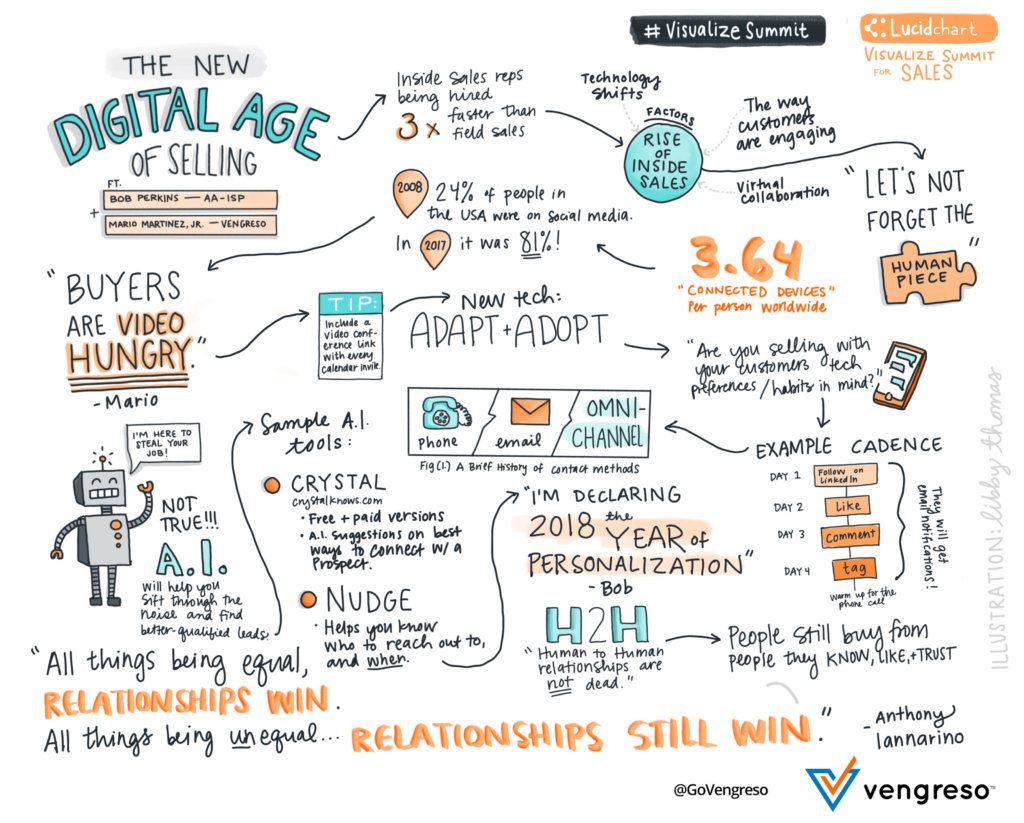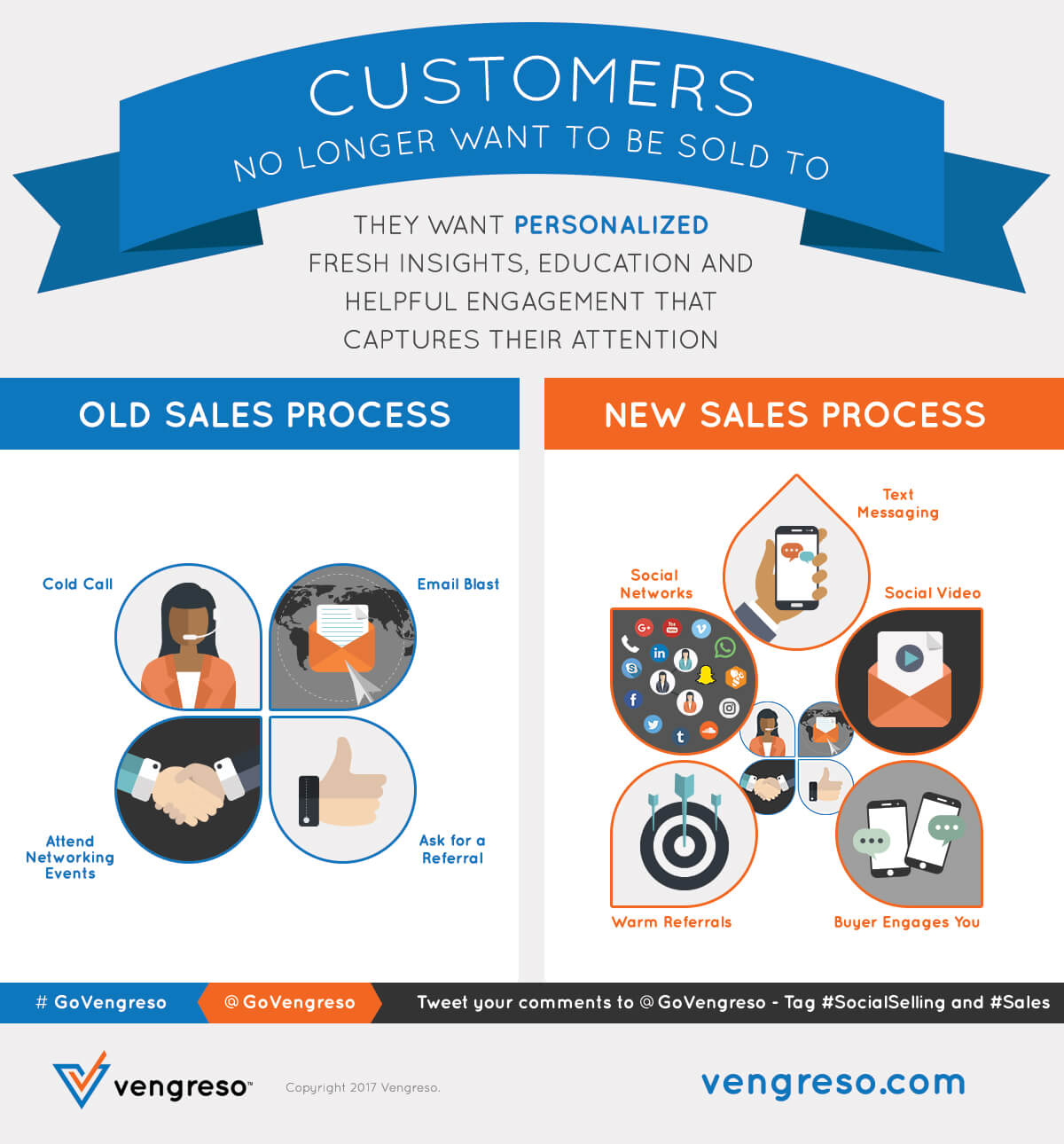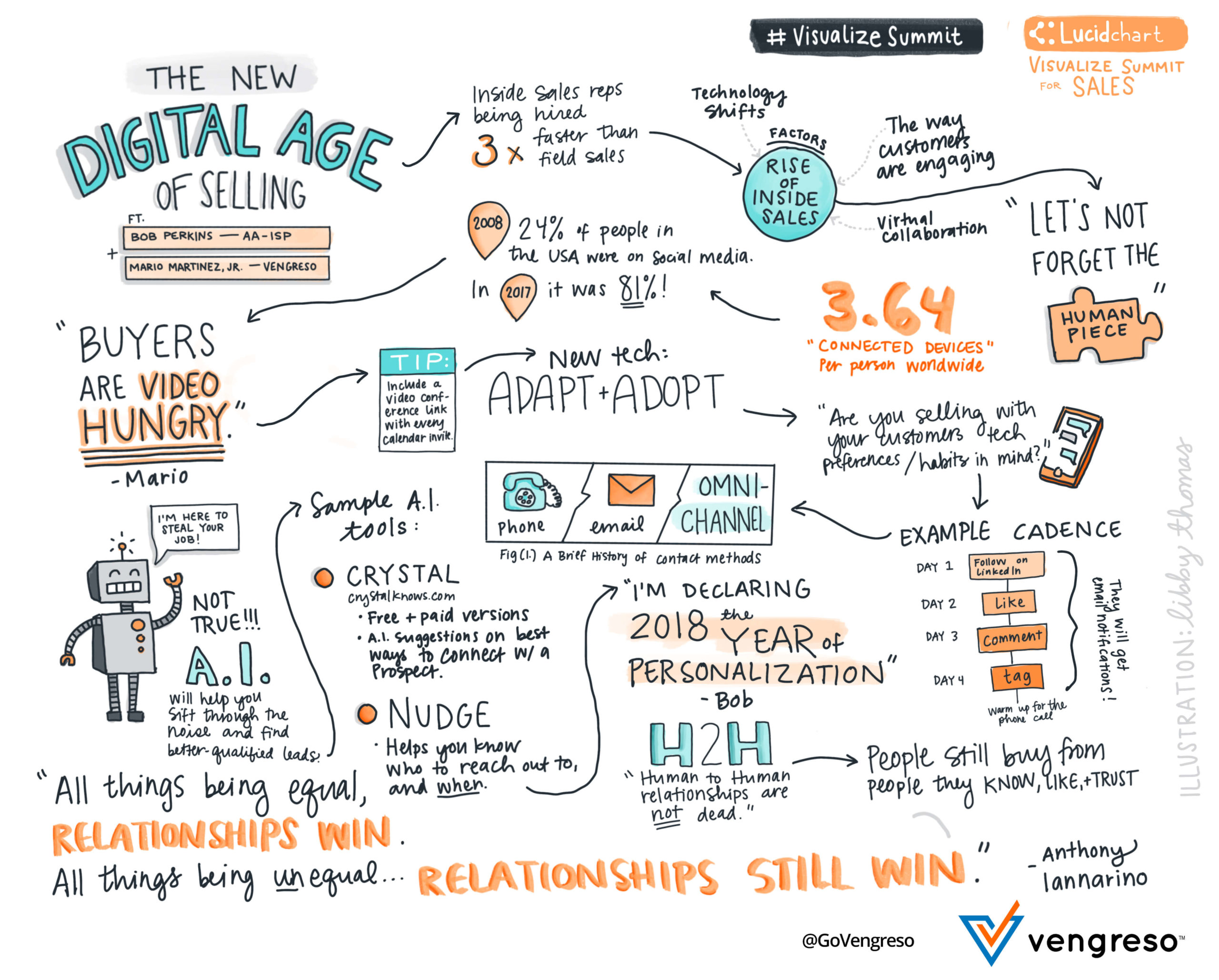Some time ago, Bob Perkins from the American Association of Inside Sales Professionals and I participated in Lucidchart’s Visualize Sales Summit with 30 other top sales leaders. Although the speakers came from very different backgrounds and industries, one theme came across loud and clear: B2B sales is changing, and it’s happening fast. Nowhere is that more apparent than when you look at the B2B sales digital transformation that is deeply influencing the industry.
I’d like to share a few of the insights that we shared with salespeople from across the country on how you can stay ahead and take advantage of digital sales.
The State of Digital Sales
With exclusive research from the American Association of Inside Sales Professionals (AA-ISP) and research from companies like ZS Associates and InsideSales.com, it’s easy to see that inside sales is a key area for growth in the industry. Studies show that:
- About 80% of companies are adding significant sales headcount (AA-ISP).
- The hiring pace for inside sales is three times greater than for field sales (InsideSales.com).
- Resources are being shifted at five times the magnitude from outside sales to inside sales efforts (InsideSales.com).
- Discrete quota owned solely by inside sales for enterprise-level accounts is $2.1 million, indicating that companies are putting more and more revenue responsibility on inside sales (ZS Associates).
Looking at this data, it’s important to understand what is driving this fantastic growth in sales. One of the key driving forces is digital transformation. It affects the sales industry so profoundly that companies like SAP and IBM have started calling inside sales teams “digital sales.” Let’s talk about what digital sales transformation really means.
Defining Digital Sales Transformation
 In the context of this article, digital sales transformation is not the same as your IT team’s definition for digital transformation, which involves changing back-end systems and operations within a company. What we’re focused on here is the digital sales transformation driven by innovative sales technology from a leading software development company, revolutionizing the way salespeople operate worldwide.
In the context of this article, digital sales transformation is not the same as your IT team’s definition for digital transformation, which involves changing back-end systems and operations within a company. What we’re focused on here is the digital sales transformation driven by innovative sales technology from a leading software development company, revolutionizing the way salespeople operate worldwide.
What type of technology are we referring to? Technology that our customers carry in their pockets. The technology that allows us to communicate with customers face-to-face. Even artificial intelligence can help us understand our buyers’ personalities. This includes cutting-edge tools like conversational AI contact center solutions, which enable businesses to engage with customers in real-time, providing personalized and efficient support.”
Combining these types of technology with a human element will help you move through the buying cycle faster than ever before.
However, many sales and marketing teams continue to face these 8 challenges to growing sales revenue:
- Content Marketing Institute reports that 75% of B2B marketing professionals rate their content marketing approach as “minimally successful” or “moderately successful.”
- Sales and Marketing remain in silos, with little or no alignment to create what sales needs to digitally attract their buyers and what marketing needs to amplify the brand and grow sales leads.
- Some sales reps and leaders are still of the mindset that this “thing” called social networks is a phenomenon just for those millennial kids who want to “play.”
- Sales reps and leaders believe that using LinkedIn to do research or send an inMail is “social selling”.
- Marketing leaders have failed to equip their sales teams with a personal digital brand that attracts and helps their buyers.
- Sales and Marketing leaders have not implemented a digital selling environment that includes the use of content sharing (employee advocacy), personal digital branding, social networks, texting, social video, and warm referrals.
- Sales leaders have also failed to integrate digital sales with traditional sales methodologies such as:
– Leveraging the phone to call someone with insights
– Using email in a way that creates a human to human connection
– Developing a cadence program that includes outreach via social video, texting, email, phone, social networks, etc. - Sales and Marketing leaders are searching for new talent with the same set of lenses they have always used.
If any of those challenges resonate with you, you can take solace in the fact that you are not alone. As a former VP of Sales and now CEO of a virtual sales training company, I know firsthand that most organizations suffer from at least one of these challenging issues, if not all of them. But please note that if you continue to ignore these challenges, you will be doomed to fail.
Winning in sales isn’t easy, but it never has been.
Here are a few tips on how to take advantage of the digital sales transformation revolution.
Leveraging the Omnichannel Experience
With the changes that digital transformation has brought to the sales world, we are now working with buyers who are:
- Digitally connected —As of January 2021 there were 4.66 billion active internet users worldwide – 59.5 percent of the global population. Of this total, 92.6% (4.32 billion) accessed the internet via mobile devices.
- Socially engaged —80% of the US population has a social networking profile.
- Mobile-attached —81% of the US population owns a smartphone, and 17% are dependent on their smartphone for Internet access.
- Video-hungry —YouTube is the only social media platform that’s growing 100% year over year, and 59% of executives share a video within the workplace at least one time per week.
Knowing all of this about our buyers, are we as salespeople engaging with and responding to our buyers with that information in mind?
Buyers expect to be able to interact and communicate with sales in a variety of different ways (Facebook, websites, marketing emails, text messaging, etc.), and they expect that experience to be consistent regardless of where, when, or how they choose to interact with the company. To meet these expectations, sales organizations need to be a part of an omnichannel experience for their customers, prepared to engage with them on multiple fronts.
Luckily the omnichannel experience isn’t just about the customer being able to interact with salespeople in a variety of ways. It also gives us as sales professionals the opportunity to be proactive and interact with prospects across multiple channels.
One way to leverage the omnichannel experience is to use social media to warm prospects up for a phone call. You could create a cadence that would help you start building a relationship with your prospects before you even get on the phone. Here’s a quick example:
Day 1 : Add a prospect on LinkedIn. Your prospect will get a notification with your request.
Day 2 : Comment on a piece of content that the prospect will see (it’s especially good to comment on something that the prospect has posted recently).
Day 3 : Tag your prospect in a post about a valuable piece of content.
Those are already three valuable touchpoints that can prepare your buyer for a phone call. When your prospect gets a request for a meeting, they’ll see your name and think, “That name looks familiar.” They’ll check LinkedIn and realize that they have read some of your posts and seen some of your tweets. You’ve just gone from a call that would be completely cold to a warmer one.
In addition, when you use social media notifications instead of email, your buyer will get a visual notification of your message, as well as an email in their inbox from the social platform you used to contact them. Spam filters are a lot less likely to stop emails from a social media platform versus emails that come from an unknown email address. Social media is a great way to get your message through, especially if your message includes media like a video or a picture that could easily set off a spam filter.
Today's Buyers are digitally connected, socially engaged, mobile attached, and #video hungry. Is your #sales team? @m_3jr shares how to leverage the omnichannel experience with @bobperkins. @lucidchart @aa_isp #socialselling #VisualizeSummitClick To TweetThe Modern Sales Sequence for Prospecting
In the following video, Sebastian Benitez, Vengreso’s Market Development Manager, explains how to create a sales prospecting cadence that will allow sellers to connect with modern buyers without being pushy. Check it out!
Using Video for Face-to-Face Communication
Although video calls have been around for a while, the annual top challengers report at AA-ISP shows that only about 47% of inside sales organizations use video conferencing at least occasionally. Only 23% to 26% use video conferencing regularly. This is a huge missed opportunity.
In the inside sales world, you are making a grave mistake if you set up a meeting with a prospect or a client that is over the phone instead of over video. Every calendar invitation that you send out should specify that you want to schedule a 15-minute “video” conference, 30-minute “video” conference, or 60-minute “video” conference.
You’d think that even when you specify a video conversation in a meeting invitation, people might prefer to just call in via phone. From what Bob and I have seen, that happens only about 20% of the time. Most people connect to the call right through the video link.
For me, the best practice is to always have my video turned on. About half of the people who use the video call link leave their video feeds on so we can have a face-to-face conversation. Every once in a while you will get someone who is not prepared to be on video, and then other times people don’t realize their video cameras turned on at the beginning. Bob mentioned that the moment that he sees a contact who wants to turn off their video, he always tell them, “Susie, Billy, Bobby, whoever it is, I already saw you. It’s too late. Turn the video back on.” And he’ll often get a positive response. Face-to-face conversations are always more effective than the phone on its own. Still not convinced? Here is an article on using video for sales that I’m sure you’ll find of tremendous value.
Learning Your Buyer’s Personality with Artificial Intelligence
So many people worry that artificial intelligence (AI) is going to take over sales jobs and replace us. That, in our opinion, is far from the truth.
What the rise of AI really means is that we’ll be able to leverage artificial intelligence to make us smarter and to help us interact more effectively with our buyers. A great example of AI that can enable sales professionals is an app called Crystal, an app that I recommended in the training. It analyzes thousands of touchpoints on the web to help us figure out how we can better communicate with an individual based on their personality.
What does that look like in practice? As salespeople write emails to prospects, Crystal can give them advice on tone. For example, Crystal might tell you, “John prefers a very direct approach. You probably don’t want to beat around the bush.” Technology like Crystal will enable salespeople like us to write tailored communications and messaging based on the way buyers interact online.
When you can target your sales message based on personality, you’re positioned to win a lot of deals that you would have lost otherwise. Bob confirmed this—he has seen plenty of demos where two reps say exactly the same thing, and one opportunity moves forward while the other one does not. Sometimes that’s because one of the sales reps didn’t communicate in a way that resonated with that particular buyer’s personality. Using a personality analysis could help solve those problems.
Will #AI replace #SalesReps and the minimize human connection? @m_3jr says it's far from the truth and here's a good reason why people in #sales need to be excited about it. @lucidchart @aa_isp #socialselling #VisualizeSummitClick To TweetUsing Artificial Intelligence to Save You Time and Effort
Artificial intelligence can do more than just help salespeople to identify a prospect’s personality. It can also help them to:
- Identify the best time to reach out to a prospect. With tools like Nudge, you can use social listening to identify buying triggers and to find key contacts.
- Better predict when a deal is going to close.
- Improve lead quality with smarter lead qualification filters.
- Streamline the scheduling process for a call.
- Automate some of the necessary evils of a sales job (e.g. filling out forms).
- Identify champions or blockers on a deal with tools like Lucidchart’s new integration with Salesforce.
All in all, artificial intelligence isn’t something to be afraid of. It’s something to stay ahead of and to use to your advantage as it saves you both time and effort.
Maintaining the Human Element in Digital Sales
Even if you never work with a buyer face-to-face, digital sales still needs the human element to be successful. You need to put your face on video calls to build trust. The best way to read someone is still to be able to see someone’s expressions. You need to be able to feel, hear, and see passion, excitement, questions, and concerns because people still buy from people who they know, like, and trust.
Recently I received a verbal offer on one of my deals, and I asked the buyer, “Why did you choose us over our competition?” The buyer’s response spoke volumes. They felt like we had truly understood the need to baby-step them through a digital sales training program and they felt confident that our team had the resources to handhold the entire organization.
That response did not happen as a result of just pushing my platform and my product and my methodology. That happened by truly listening, engaging, and responding. And that can’t be replaced through artificial intelligence.
At the end of the day, I agree with Anthony Iannarino, who said, “At the end of the day, remember one thing. All things being equal, relationships win. All things being unequal, relationships win.” That’s what it comes down to.
4 Pillars of Digital Sales Transformation
Buyer behavior has changed. Sales must keep up. Today’s modern buyer requires — and deserves — a modern seller. What makes a seller a modern seller? It’s not just a rep who knows how to run a filter on LinkedIn or tweet on Twitter. Rather, a modern seller is someone who has adopted the correct mindset, possesses the correct skillset and implements the correct toolset to accomplish their job. What is that job? Create more conversations with buyers.
Forrester’s Mary Shea put it this way in B2B Buyers Make The Case For Better Marketing And Sales Alignment:
“Your buyers want contextual interactions with both human and digital assets across a holistic but non-linear journey. And, by in large, they want their experiences with salespeople to be high value or frictionless.”
The need to bridge the gap between B2B buyers and sellers and create a holistic, high value/low friction journey has given birth to the Digital Sales Transformation, a movement that Vengreso is leading and advocating to enable sales & marketing teams to provide the content, digital and traditional interactions buyers want and need at every point along their journey, even before they ask for it.
If you are thinking, “That is not what our salespeople do today,” I don’t doubt you. But this is exactly what forward-thinking sales and marketing organizations that thrive in today’s digital selling ecosystem are doing. Think of it as the “old” way of selling vs. the “new” way of selling.
This infographic compares the status quo with the Digital Sales Transformation.

Which side are you and/or your sales team on today?
In a digital sales training a while ago, I taught an NFL sports team how to combine digital selling with traditional selling. I was hired by that NFL team not because I cold-called the buyer, but because I took a holistic digital sales approach to the selling model. Here’s what happened.
A buyer engaged with someone else’s status post that I was tagged in … I noticed he also viewed my optimized LinkedIn Profile … I reached out via a customized connection request. He responded. He was curious about what I did with that other NFL team. We hosted a call. From there, I engaged not just on social media but by phone, video, text, email and social media over the period of 7 months. I used every part of the new integrated digital sales methodology as shown in the infographic above at least 3 times each … I won the business.
Because I had already embraced the four pillars of the Digital Sales Transformation, I had a tremendous advantage over my competition.
Here are those 4 Pillars of Digital Sales Transformation:
1. Alignment between sales and marketing to provide content buyers need and the branding sales needs to attract their buyers
2. Mindset to consistently engage through both digital and traditional methodologies in order to get the job done
3. Skillset to shatter sales goals by understanding how to cut through the digital noise of data and leverage what is needed to create more conversations
4. Toolset to scale results is critical, as in most cases it’s a multitude of digital tools not just the phone or email anymore
By embracing these four pillars and putting them into action every day, you can enjoy the same advantage. Remember, today’s modern buyer requires a modern seller.



